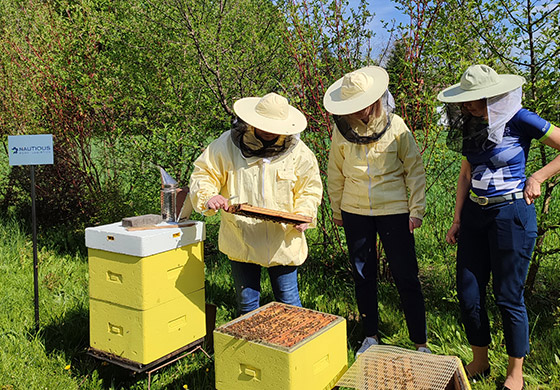What’s up with Nautiqus bees? The first honey harvest is over!
We are already in the second half of the beekeeping season. At the beginning of June we held the first honey harvest this year from our Nautiqus hives. Since the beginning of the season, the bees from our small apiary have produced almost 20 kilograms of honey. The beekeepers taking care of the apiary conduct regular honey harvesting, which involves extracting the honey produced by the bees from the combs, which are spun using a special honey extractor. The collected honey goes into jars and then to our customers 😊
What does the honey harvesting process look like?
First, beekeepers go to the hive with the necessary equipment and tools, which they use to open the so-called extension and fumigate the insects. Then they pull out the combs and sweep the bees with a special sweeper. The combs are translated into special boxes and transported to early prepared rooms, where they are hand-scrubbed. The next stage is placing the frames in a special device for spinning honey from the combs – a honey extractor. After that, the honey is drained via a faucet into a vessel with a sieve to trap any impurities. Honey centrifugation can be carried out even several times a year – this depends on the amount and maturity of the honey. The first honey harvest of the year should take place in late May or early June.
Each season means very different activities for beekeepers. In winter, they make sure the hives are insulated and remain closed so as not to disturb the bees’ rest. In the spring, the bees begin their spring flight in search of food. During this time, beekeepers observe the bees and, if necessary – feed them with natural syrups. In late spring and summer, the process of honey production continues, and beekeepers at this time proceed to honey harvesting. During this process, it is important to leave a sufficient supply of honey for the bees to survive the winter. In the summer, bee colonies are at their peak, and this is when beekeepers make what’s known as a “set-aside” and divide the hive into smaller ones. Autumn is the period of “cleaning” and preparing the hives for winter. This is when beekeepers remove frames and bodies from the hives that will no longer be needed by the bees, and then insulate the hives before winter.
We would like to remind you that at the beginning of the year Nautiqus established cooperation with the Apiary Farm , “Sadecki Bartnik” and adopted 2 beehives, which are home to nearly 50 thousand bees. The insects are cared for by experienced beekeepers. Each bee colony is capable of producing 20 to 30 kg of honey per year.
How CAN YOU help the bees?
- don’t burn grass,
- establish flower meadows,
- build a hotel for pollinating insects on your balcony, terrace or garden,
- limit chemical fertilizers,
- prepare a drinker for bees on your windowsill, balcony, terrace or garden,
- schedule work in the garden for times when the insects are inactive,
- reduce the area of lawn mowing.


